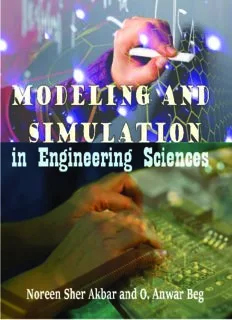Table Of ContentModeling and Simulation
in Engineering Sciences
Edited by Noreen Sher Akbar and O. Anwar Beg
Modeling and Simulation in Engineering Sciences
Edited by Noreen Sher Akbar and O. Anwar Beg
Published by ExLi4EvA
Copyright © 2016
All chapters are Open Access distributed under the Creative Commons Attribution
3.0 license, which allows users to download, copy and build upon published articles
even for commercial purposes, as long as the author and publisher are
properly credited, which ensures maximum dissemination and a wider impact of our
publications. After this work has been published, authors have the right to
republish it, in whole or part, in any publication of which they are the author,
and to make other personal use of the work. Any republication, referencing or
personal use of the work must explicitly identify the original source.
As for readers, this license allows users to download, copy and build upon
published chapters even for commercial purposes, as long as the author and publisher
are properly credited, which ensures maximum dissemination and a wider impact of
our publications.
Notice
Statements and opinions expressed in the chapters are these of the individual
contributors and not necessarily those of the editors or publisher. No responsibility is
accepted for the accuracy of information contained in the published chapters. The
publisher assumes no responsibility for any damage or injury to persons or property
arising out of the use of any materials, instructions, methods or ideas contained in the
book.
Publishing Process Manager
Technical Editor
Cover Designer
Спизжено у ExLib: avxhome.se/blogs/exLib
ISBN-10: 9953-51-2609-1 Stole src from http://avxhome.se/blogs/exLib:
ISBN-13: 978-953-51-2609-6
Спизжено у ExLib: avxhome.se/blogs/exLib
Print
ISBN-10: 953-51-2608-3
ISBN-13: 978-953-51-2608-9
C ontents
Preface
Chapter 1 Numerical Simulation in Microforming for Very Small
Metal Elements
by Krzysztof Mogielnicki
Chapter 2 Numerical Simulation of Compressible Reactive Flows
by Bing Wang, Zhao Xin Ren and Wei Wei
Chapter 3 Hybrid Time-Frequency Numerical Simulation of
Electronic Radio Frequency Systems
by Jorge F. Oliveira
Chapter 4 HgCdTe Mid- and Long-Wave Barrier Infrared
Detectors for Higher Operating Temperature Condition
by Małgorzata Kopytko and Piotr Martyniuk
Chapter 5 Numerical Simulation Methods Applied at Fiber
Grating Sensors Design
by Dan Savastru, Sorin Miclos, Marina Tautan and Ion Lancranjan
Chapter 6 Charge Collection Physical Modeling for Soft Error
Rate Computational Simulation in Digital Circuits
by Jean-Luc Autran, Daniela Munteanu, Soilihi Moindjie, Tarek Saad
Saoud, Victor Malherbe, Gilles Gasiot, Sylvain Clerc and Philippe
Roche
Chapter 7 Training Images-Based Stochastic Simulation on
Many-Core Architectures
by Tao Huang and Detang Lu
VI Contents
Chapter 8 Numerical Simulation of Laser Processing Materials:
An Engineering Approach
by Guillaume Savriama and Nadjib Semmar
Chapter 9 Mathematical Modeling for Nanofluids Simulation: A
Review of the Latest Works
by Mohammad Reza Safaei, AminHossein Jahanbin, Ali Kianifar,
Samira Gharehkhani, Akeel Shebeeb Kherbeet, Marjan Goodarzi and
Mahidzal Dahari
Chapter 10 Application of Phase-Field Method to the Analysis of
Phase Decomposition of Alloys
by Erika O. Avila-Davila, Victor M. Lopez-Hirata and Maribel L.
Saucedo-Muñoz
Chapter 11 DEM Simulation Based on Experimental Testing
by Dr Šarūnas Skuodis
Chapter 12 Impact of Fluid Flow on Free Radical Polymerization
in a Batch Reactor
by Gerardo M. Pineda-Torres, Cecilia Durán-Valencia, Fernando
Barragán-Aroche and Simon López-Ramírez
Preface
This book features state-of-the-art contributions in mathematical,
experimental and numerical simulations in engineering sciences. The
contributions in this book, which comprise twelve chapters, are
organized in six sections spanning mechanical, aerospace, electrical,
electronic, computer, materials, geotechnical and chemical
engineering.
Topics include metal micro-forming, compressible reactive flows, radio
frequency circuits, barrier infrared detectors, fiber Bragg and long-
period fiber gratings, semiconductor modelling, many-core architecture
computers, laser processing of materials, alloy phase decomposition,
nanofluids, geo-materials and rheo-kinetics. Contributors are from
Europe, China, Mexico, Malaysia and Iran.
The chapters feature many sophisticated approaches including Monte
Carlo simulation, FLUENT and ABAQUS computational modelling,
discrete element modelling and partitioned frequency-time methods.
The book will be of interest to researchers and also consultants
engaged in many areas of engineering simulation.
Chapter 1
Numerical Simulation in Microforming for Very Small
Metal Elements
Krzysztof Mogielnicki
Additional information is available at the end of the chapter
http://dx.doi.org/10.5772/64275
Abstract
Microforming is a technology of very small metal elements production, which are
required as a parts for many industrial products resulting from microtechnology. This
chapter gives a review of the state-of-the-art microforming of metals and its numeri‐
cal simulations. Phenomena occurring in the miniaturization of microbulk-forming
technologies are described. The main problems in microforming are size effects, which
have physical and structural sources and directly affect the material flow mechanics in
microscale. Size effects must be taken into account in all areas of the forming process
chain, demanding new solutions, especially in workpiece structure and die surface
numerical modeling.
Keywords: microforming, size effects, numerical simulation
1. Introduction
Trend of miniaturization of everyday devices increases industry demand for efficient produc‐
tion of miniature parts. Machining production technologies of small-dimension elements by
turning, milling, and polishing are well known for a long time. However, these methods are not
efficient enough for the great demand for small and handy devices. This makes engineers to
search for new methods of microelements manufacturing or to adapt traditional ones for the
requirements of miniaturization.
Microforming is an adopted technology of production of small parts by metal forming. This
process is characterized by good productivity, high dimensions accuracy, proper surface
smoothness, high material usage, and good mechanical properties of manufactured items,
Description:Эта книга посвящена математическому, экспериментальному и численному моделированию в области инженерных наук. Темы включают формирование металлических микростр

